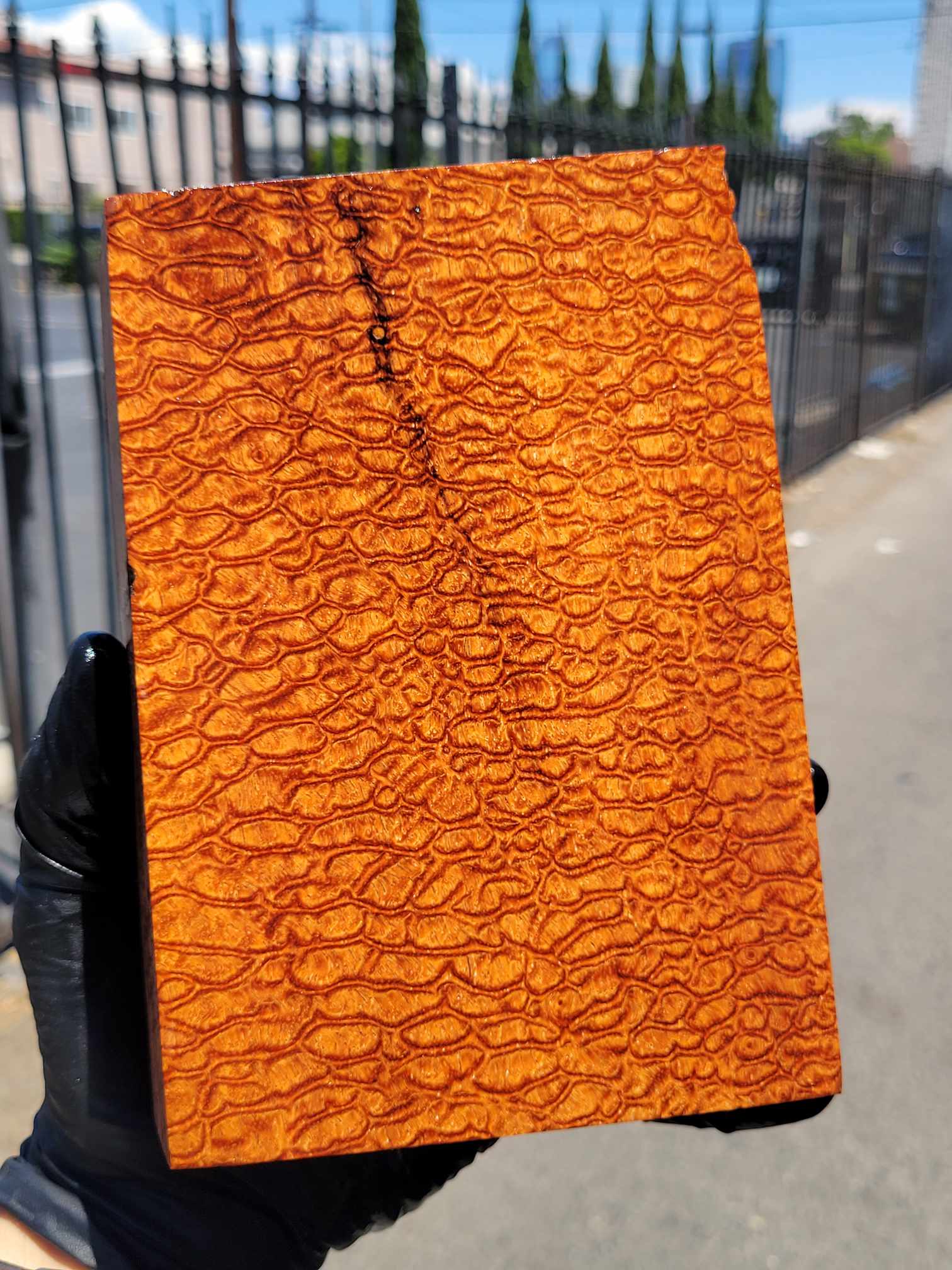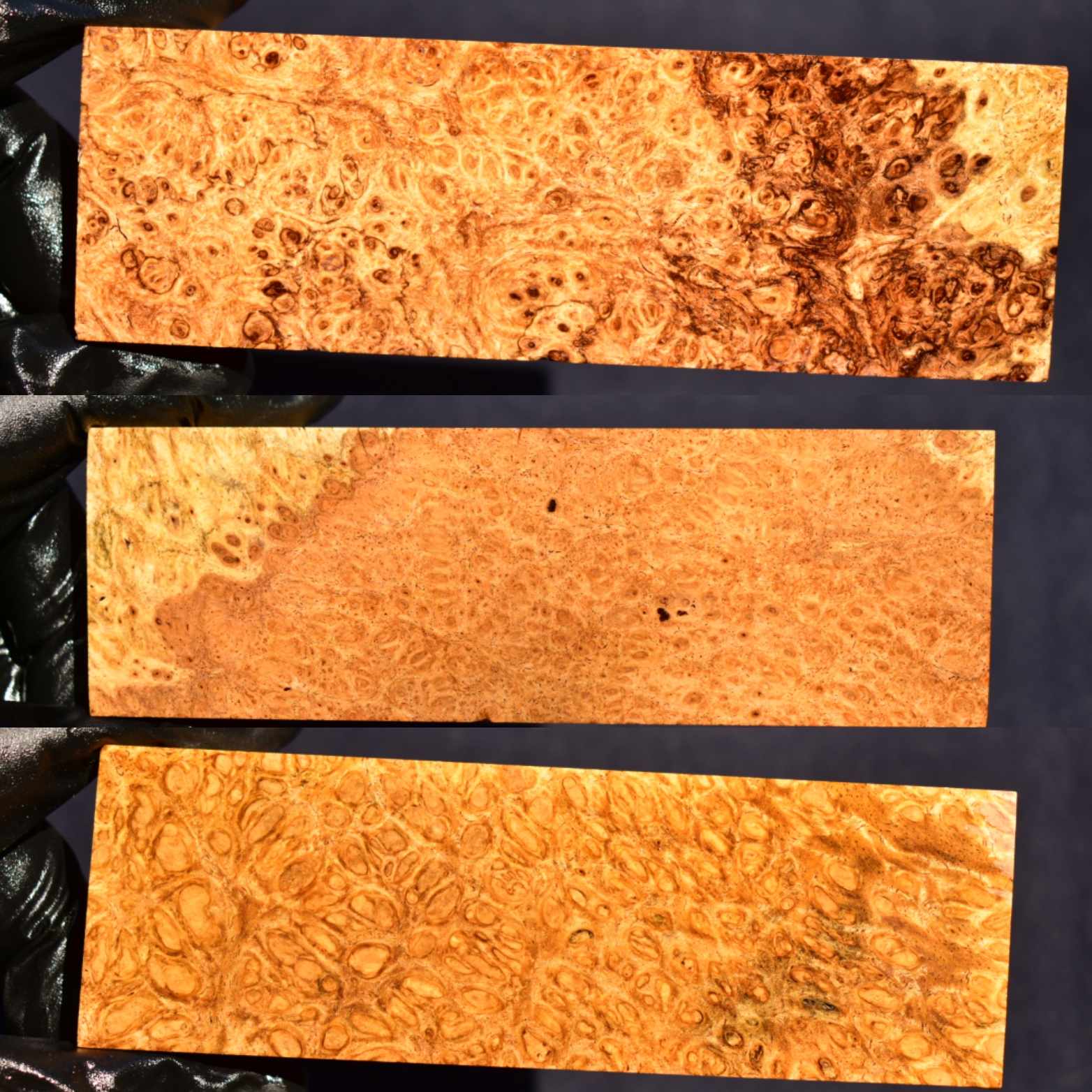What is figured wood? What causes curly grain in wood? How come a piece of curly wood may seem to have less figure after its used, and which faces of a figured piece of wood will show the best figure?
These are common questions about figured wood. In the end all wood figure is a product of grain direction and the anisotropic nature of wood. Anisotropic means that the properties of wood are different depending on the direction of the material. That is because wood is a composite material. All wood is made of 2 compounds, cellulose and lignin. Think of wood as lots of thin straws all glued together, running in the same direction. The straws are cellulose, and the glue is lignin. If you glued together a cube of straws, all lined up you would have 2 kinds of faces. The 4 sides of the cube would be more or less the same, showing the long edges of many straws next to each other. This is called Long grain. The top and bottom surfaces would be different though, they would show only the ends of the straws. This is called end grain. The properties of these 2 different faces would be different as well. You could also cut the cube at an angle, thus creating a surface that is part end grain, and part long grain. The percentage of each would be a result of the angle of intersection relative to the angle of the straws. You could discribe a 45 degree cut as being half long grain, and half end grain character. A 30 degree cut would be 66% long grain and 33% end grain and so on. This is a simple primer of the anisotropic nature of wood.
This shows the difference between end and long Grain.

However, wood has another factor, the grain angle. Grain angle is a product of the fact that trees grow in rings. Depending on the angle the rings make with the surface, wood can be described as either Flatsawn, quartersawn or riftsawn.
When the angle between the rings and the surface is low, that is to say the rings are nearly parallel to the surface the grain is described as being flatsawn, sometimes called plainsawn.
When the angle between the rings and the surface approaches 90 degrees, that is to say the rings are perpendicular to the surface the grain is described as being quartersawn.
The 3rd designation is right sawn, where the angle is close to 45 degrees. This is of most importance with woods like oak, but it should be mentioned. The diagram below shows what the end of a board with the different types of grain would look like.

What is Curly/ Quilted Wood?
Curly wood is wood whos individual rings form waves in the plane of the tree. Another way to describe it is that Curly figure is a form of transverse wave. Each individual straw has become something of a crazy straw and now appears as a sign wave. When looking at the Flatsawn/ Plainsawn face of a a piece of curly wood, you would see the grain wiggling back and forth. In curly grain, the direction of curl is parallel to the direction of rings, and so a quartersawn face, perpendicular to the rings would intersect this figure and show the curly grain.


This sample of Curly acacia shows the appearance of flatsawn grain in curly wood. Each line forms a sine wave shape, but no figure is seen yet as all the wood is in one plane.
Quilted figure is sometimes used to describe any wide spaced curl, but quilted figure is inherently different from curly figure. Curly grain describes a transverse wave that occurs in the plane of the tree. Quilted figure is the opposite, it is waves that form out of the plane of the tree. It is caused by grain waves perpendicular to the rings of tree. That means that if you saw the trunk of a tree with quilted figure, it would have a 3d surface as seen below. The surface of the tree has texture, and on the quartersawn face shown, relatively little figure is visible. You can however see each grain line as a wave, similar to the flatsawn appearance of curly wood. To show quilted figure, the wood would have to be flat sawn. Since a flatsawn surface would be parallel to the growth rings, and the undulation of quilted figure wood are perpendicular to the rings, the figure would appear. In the image below, see how the entire tree has waves in it, traveling up and down the length of the wood? If you were to cut flatsawn, I.E to cut through the waves the grain would alternate flat, then going into the plane, then flat, then coming out. This would cause a quilt figure, with the spacing of the quilt being the period of the waves of the grain
![[IMG]](https://i.imgur.com/U4tCZlG.jpg)
A piece of quilted Eucalyptus, showing the quartersawn face and the edges flatsawn. If cut flat, the edges would show quilted figure.
So, now that you understand the Anisotropic nature of wood, how does that produce curly figure?
One of the properties that changes with the percentage of end and Long grain character is the index of refraction, or how much light the is reflected. Endgrain reflects light less strongly than face grain does. And as discussed above, grain can undulate through wood, and if a plane of wood goes through this, in some areas the grain will be rising up out of the surface, in parts it will be flat to the surface, and parts it will be going back down into the surface. These areas where the grain is coming up or going down have part endgrain character, which means they reflect less light than the areas where the grain is flat to the surface. This results in alternating bands of more and less reflective wood, giving rise to figure. With the grain going in and out of the plane of the surface, repeating areas of end grain and long grain character wood produce the shimmering effects of figured wood.
![[IMG]](https://i.imgur.com/Dcgcp3P.jpg)
This diagram shows and example of when figured wood is planed flat. As you can see, the angle the grain makes with the surface changes with a regular period across the surface of the wood.
This also gives insight into how the appearance of curl can vary. Factors can include the period of the oscillations, i.e how many curls/ quilts per unit of distance?
Another factor can be the angle of curl. Woods like koa, rosewood and acacia tend to have large relative amplitudes of curl waves. That means that the difference between the long grain and end grain character areas will be very high, as the areas with end grain character would be approaching 100% end grain and thus show a stronger contrast between the long grain areas.
Another factor is the difference in refractive index between the end grain and long grain. In general, dense, fine grained woods like rosewood, koa, narra or maple have a greater difference in reflectivity between long and end grain wood than coarse grain woods like oak or hickory. That means that the same amount of curl will appear more strongly in a wood like maple than on a wood like oak.
Samples of Curly woods
Ringed Gidgee


Curly Rosewood samples
Birdseye Figure: Birdseye figure is often misunderstood and sold as being burl figure. It is not, and arises from a different but unknown mechanism. What is known is that the eyes are almost always radial in nature. Like the eyes of a burl, they show best when cut perpendicular to their direction of formation, which means birdseye figure will show best on a flatsawn section. Real birdseye figure is a rare thing, and most often seen in hard maple. Recently, i was able to source Birdseye Viet rosewood, an incredibly rare species that shows true birdseye figure. Birdseye figure is a type of figure that will greatly benefit from a high grit finishing, as more figure will appear as the surface is refined.
Birdseye Vietnamese Rosewood
Pommele/ Bubble/ peanut and so on: All of these figures are similar in natural to quilt, the involve movement of grain parallel to the grain of the wood an are thus best shown in flatsawn pieces. One of the most famous and least understood of these is the Xylay figure in Afzelia Xylay. Its an incredibly rare wood, and the strange, bubbling quilted figure is seen best on flat sawn chunks. I have been asking suppliers what they know about it and little information has come to light.


Samples of Afzelia Xylay
Burls:
Burls are special to handle makers. We love them more than any other craftsmen. And their beauty is palpable. But what is a burl? How do you maximize its beauty?
Well, there are two main types of burl. Grain burls and eye burls. Grain burls will often look like a brain, randomly formed grain with a smooth to slightly knobbly surface. These burls will lack the dramatic eyes that are loved. These burls tend to form around dead wood or at an injury as the tree attempts to grow over a wound.
The much more valued burls are eye burl. Their surface will often look covered in pins![[IMG]](https://i.imgur.com/JmSTxwa.jpg)
Red Mallee Burl sample
This burl cap shows the tell tale pins of an eye burl. These burls are caused mainly by a bacterial infection. This bacteria creates a hormone that in trees induces budding. This hormone buildup causes the tree to form many small buds that due back and become encased in more buds. They tend to form from a single point. And emanate outward. Burls can grow on nearly any tree species, but some are much more prone to growing burls than others. Maple and walnut are famous domestic species, but woods like Amboyna, Afzelia, teak and other exotics can create truly amazing burls.
Burls are always prone to flaws, as they are very much tumors. They can have cracks, checks, ingrown bark or other defects. Because they are rich in new growth buds, they are also very attractive to all manner of bugs which will seek them out and can result in severe bug damage.
You can think of them as half of a sphere. The center of the flat side of sphere is the site of the infection, with many tubes radiating out from this point. If you were to cut a surface parallel to the flat of semi sphere, you would be rewarded with a surface full of eyes, as you would intersect the tubes of the burl. If you were to cut perpendicular to the flat of the burl, you would see a figure reminist of curly grain, as you slice the tubes of the buds in half along their width. While burls dont have a classic "Grain" the difference between eyecut and ray cut burls serves the same function for the most part. Burls will often also con![[IMG]](https://i.imgur.com/OpjGe1B.jpg)
Ebony burl, amboyna burl, Amboyna burl



Burmese teak burl, acacia burl, satinwood burl
